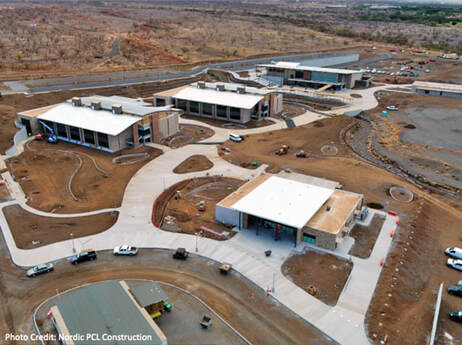|
Challenging the Housing Czar
This week we look at Governor Green‘s Emergency Proclamation Relating to Housing, and his use of the emergency statutes to suspend many of the laws that account for delays upon delays in housing starts. The proclamation has been on the books for a couple of months. It came after much effort was expended in developing the temporary rules that would be used under the emergency proclamation. As expected, some organizations unhappy with the proclamation and its consequences sued to invalidate it. (Which, by the way, is the legitimate way to challenge its validity. Threats of violence or worse against the housing administrator, causing her to resign for the safety of her and her family, deserve nothing but contempt.) Some of the proclamation’s detractors point out that housing crisis is not what’s normally contemplated in a state of emergency. With hurricanes, tsunami, and wildfires, for example, the event hits, it goes away, and leaves death and destruction in its wake. The housing crisis certainly doesn’t fit this mold; but, then again, neither does COVID-19, which was used under Governor Ige to justify chained 60-day emergency proclamations spanning multiple years. The Legislature was in session multiple times within the duration of the pandemic, and it implicitly approved the use of emergency authority then; some bills were introduced that would have modified or limited the Governor’s authority for emergencies of long duration, but they did not pass. The opponents also focused on the intricate, detailed rules attached to the proclamation, which were the product of many weeks of considered thought, outreach to and input from dozens of stakeholders. That doesn’t happen in the case of a real emergency, argue the opposition, therefore the housing crisis can’t be a real emergency. To them I have two things to say. First, I would much rather be governed by rules put together after much thought, deliberation, and stakeholder involvement than by ones hastily assembled while staring down a crisis. If a government agency is doing its job right, the rules it puts out should always be the former rather than the latter. Second, if properly vetted rules were drafted by an agency to be used in a possible emergency that didn’t happen to be at our doorstep, I would call it prudent planning rather than a waste of taxpayer resources. Does our response to a real emergency have to be thrown together at the last minute to be valid? Next, the opposition seems to be saying that the housing crisis was long years or decades in the making, so it lacks the suddenness required of an emergency. As our statutes define an emergency or disaster, however, suddenness is not required. What is required is an occurrence, or threat of one, that results in injury, harm, or loss of life, property, or the environment. If astronomers found an asteroid that they predicted would slam into Oahu in three months and bring half of the island undersea, for example, would that not qualify as an emergency? And we certainly have been losing people — fortunately they haven’t been sickened or killed, but have been boarding one-way flights to Anywhere But Hawaii. Will any good come of the emergency housing proclamation? It’s probably too early to tell yet. But it does represent a fundamental change from past administrations who considered themselves boxed in by the myriad of state and county rules and processes that have grown up over multiple generations. Sometimes you just have to break the current system before you can see if something else works better or more efficiently. If there are better solutions discovered in the process, our legislators can take steps to adopt them. If there are none, then the noble experiment validates the status quo. But, given the dismal state of our housing supply and the near-constant reports in recent years of steady population decline, my bet is on the success of the experiment. I look forward to the likely upcoming struggle to implement its findings.
0 Comments
Taxing Government Benefits
We’re still well into the aftermath of the Maui and Hawaii County wildfires. Our governments have opened up their coffers and have begun doling out lots of money toward disaster relief and emergency assistance. Legitimate questions now need to be asked about whether the government is going to want to take back some of that money in taxes. It’s an important issue for people in the midst of the disaster because if the money is taxable and a wildfire victim spends all of it on necessities like food and shelter, is that victim going to have major problems down the line because that person needed to set a bunch of that money aside for taxes and didn’t? On August 30, 2023, the Internal Revenue Service released Notice 2023-56, a technical document (probably best appreciated by tax geeks and legal wonks) that is supposed to help people make sense out of the different kinds of government payments they may be receiving, and whether they are taxable. The Service noted that it isn’t always easy to figure out whether a particular payment is subject to tax, and it basically decided to look the other way for 2022 payments; but, since they can’t do that forever, they decided to publish some rules. Usually, if you receive money and you get to keep it, that money is income for tax purposes. The Notice discusses three exceptions: state tax refunds, “general welfare” payments, and disaster relief payments. State tax refunds aren’t normally taxable, except that if you took an itemized deduction for a state tax payment and then get some or all of the payment back, you might have to walk back your deduction. The Notice also said that some “refundable credits,” which are paid to you even if you didn’t owe tax, are not considered refunds and need to be analyzed like other payments from the government. Some payments from the government are considered “general welfare” and aren’t taxed. These payments have to be based on the need of the individual or family receiving the payments, and they can’t be a payment for services sold to the government. Many of the refundable credits that Hawaii offers to lower-income families come under that description, so they aren’t taxable. On the other hand, payments to businesses are usually taxable, but there are exceptions; many of the COVID-19 relief programs, for example, included language in the law saying that benefits wouldn’t be taxable. Businesses also need to be wary of General Excise Tax on payments related to the disaster. There is also a specific section of the federal income tax law, section 139 of the Internal Revenue Code, that applies specifically to disasters that are declared by the federal government so that FEMA gets involved. The criteria for tax exemption under this section are similar to those for general welfare payments. The payments need to be made on the basis of need, and need is presumed if the payments are directed to disaster victims. In any case, a government entity that is paying benefits needs to give you a Form 1099-G at the end of the year if the benefits are taxable. Especially if the entity has been paying benefits to other people because of other tough circumstances, it probably has some idea of whether the benefits it is paying are taxable or not. So it may be a good idea to direct specific questions to the paying entity. Getting Kids to School in Kihei
Let’s start with a simple proposition. Taxpayers pay our government to get things done. Taxpayers don’t pay our government agencies to fight each other so that nothing gets done. We focus this week on Kihei, Maui, where our Department of Education (DOE) has been trying to open a new, $245 million, high school primarily for Kihei. It’s called Kulanihakoi High School. It’s built, and has been built for some time, but it can’t open. Why? Lots of families live makai of Piilani Highway (which is a busy, four lane highway) around Kulanihakoi Street. The school was built mauka of Piilani Highway. To get to the school, kids now have to cross the highway. Concerns about the safety of having kids compete with cars here prompted the State Land Use Commission to conclude, ten years ago, that a “grade-separated crossing,” like an overpass or an underpass, needed to be built. Over the years, DOE appeared to go along with the requirement. In early 2020, when it approached Maui County for permits, it said that the design of the pedestrian overpass was already started and projected for it to be built in 2022 and 2023. But in 2021, DOE did an about-face. Instead, it went back to the Land Use Commission to ask it to change its previous order to allow it to open the school without a pedestrian crossing, citing studies (paid for by guess who) presumably showing that the pedestrian crossing was not needed. This attracted objections and demonstrations from the public, and the Commission denied the DOE’s request. At the same time, the DOE and the Department of Transportation spent $16 million on a four-lane roundabout with flashing lights in front of the school to slow traffic down and thereby eliminate (in DOE’s mind, perhaps) the need for an overpass. County officials were skeptical and arranged a meeting in late August 2022 with council members and other community members. No one from the DOE showed up to the meeting, however. In February 2023, DOE seemed to accede to the overpass, presenting some rough sketches to the community. The agency said it would ask the Legislature for emergency funding to build the overpass. Sen. Angus McKelvey, who represents the area, said that he added $15 million for the project in the Senate’s draft of the plan, but that funding didn’t make it into the state budget. It isn’t clear why the funding request was deleted; perhaps it was because that wouldn’t be enough. The Governor’s Office issued a release saying that its construction would cost more than $25 million. In March, Gov. Green announced that the state and county governments had reached a deal allowing the school to open in exchange for requiring the DOE to implement a temporary pedestrian safety plan, including shuttles for students walking to and from school, until the new pedestrian overpass is completed. The school is now slated to open in August. Let me now ask this question: If the DOE had listened to the Land Use Commission ten years ago and had not put tons of resources into studies and legal briefs trying to get the Commission to change its mind, how many millions of taxpayer dollars could have been saved – by the DOE, the Department Transportation, Maui County government, and even the Governor’s Office? |
If you wish to further discuss blog posts, please contat our office directly or contact us via Contact page.
Categories
All
|




 RSS Feed
RSS Feed